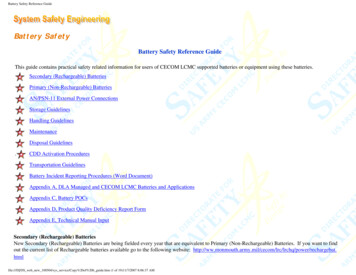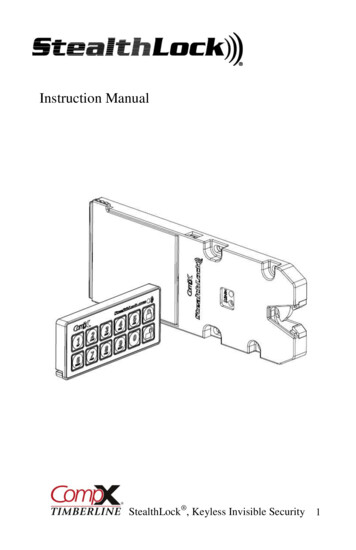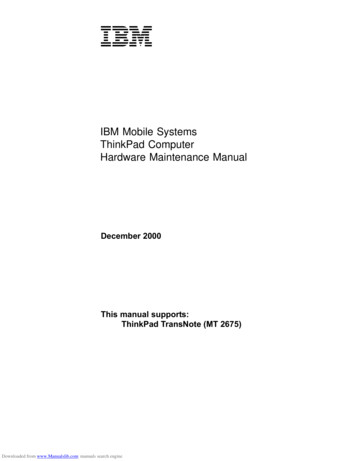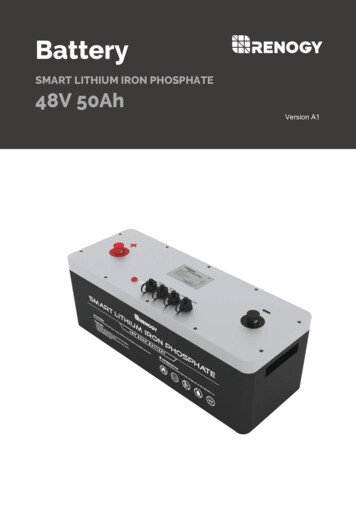
Transcription
Battery Safety Reference GuideBattery SafetyBattery Safety Reference GuideThis guide contains practical safety related information for users of CECOM LCMC supported batteries or equipment using these batteries.Secondary (Rechargeable) BatteriesPrimary (Non-Rechargeable) BatteriesAN/PSN-11 External Power ConnectionsStorage GuidelinesHandling GuidelinesMaintenanceDisposal Guidelines.CDD Activation ProceduresTransportation GuidelinesBattery Incident Reporting Procedures (Word Document)Appendix A, DLA Managed and CECOM LCMC Batteries and ApplicationsAppendix C, Battery POCsAppendix D, Product Quality Deficiency Report FormAppendix E, Technical Manual InputSecondary (Rechargeable) BatteriesNew Secondary (Rechargeable) Batteries are being fielded every year that are equivalent to Primary (Non-Rechargeable) Batteries. If you want to findout the current list of Rechargeable batteries available go to the following website: rechargebat.htmlfile:///D /DS web new 100504/sys service/Copy%20of%20b guide.htm (1 of 19)11/7/2007 8:06:37 AM
Battery Safety Reference GuidePrimary BatteriesGo to https://lrcteams.monmouth.army.mil/ipm and go to the battery support section to find further information on the batteries available in theGovernment inventoryAN/PSN-11 GPS PLGR External Power Connection RequirementsA failure mode of the AN/PSN-11 GPS PLGR has been linked to the improper installation of the wiring harness of the PLGR to the host vehicle. If thehost vehicle has two batteries in series and the PLGR connection is made ONLY to the battery not connected to vehicle ground, the PLGR ground will notbe the same as vehicle ground. This difference can cause an internal hardware failure inside the PLGR which will cause the memory battery to receive acharge from the host vehicle battery. The Lithium 3.6VDC PLGR memory battery will explode when charged. This deflagration can cause significantbodily harm and equipment damage. The following information is provided for proper installation procedures:1. The PLGR can be installed into a host vehicle using 9-33 VDC power input.2. The host vehicle typically has two batteries installed in series. Figure 1 shows two 12 volt batteries in series, providing 24 volts DC.Figure 1 Two 12 Volt Batteries in Series3. Figure 2 shows three ways to connect the PLGR to the batteries.file:///D /DS web new 100504/sys service/Copy%20of%20b guide.htm (2 of 19)11/7/2007 8:06:37 AM
Battery Safety Reference GuideFigure 2 Three Ways to Connect the PLGR to the Batteries4. Option A is good5. Option B is good, but it looks too much like C, which is bad!file:///D /DS web new 100504/sys service/Copy%20of%20b guide.htm (3 of 19)11/7/2007 8:06:37 AM
Battery Safety Reference Guide6. Just do A!Failure to comply with this installation could result in the explosion of the memory battery within a few minutes. This could result in significantdamage and bodily injury!Battery StorageThe following battery storage guidelines are provided for all battery types. Typical storage locations include convex structures for bulk storage or smallerfacilities for end item users. Precautions are also provided for specific chemistries.1. Store new batteries in original packaging. This helps to identify damage such as swelling or leakage of batteries. Swelling of the bag indicates abattery that has vented.2. Do not mix new and used batteries since it is difficult to distinguish between them.3. Do not accumulate used batteries, dispose of on a regular basis.4. Segregate storage from other hazardous materials and other battery chemistries. It is critical that lead acid batteries be kept away from nickelcadmium or nickel metal hydride batteries.5. Protect from crushing, punctures, and shorting.6. Keep in a cool, dry, well ventilated area, below 130 degrees F.7. Thermal runaway of nickel cadmium batteries may occur if temperatures exceeds 130 degrees F.8. Coordinate battery storage locations with your local fire department/safety office and have periodic inspections conducted by fire department/safety office.9. Protect bulk storage of batteries with sprinklers.10. No smoking or eating.11. Ensure that fire extinguishers are available. Use a type "AB" (H2O) extinguisher to fight fires involving small quantities of batteries. A type "D"extinguisher would be used to fight a lithium fire by professional fire fighters.Battery HandlingThe following battery handling guidelines are provided for all battery types. These guidelines are intended for use at battery storage facilities, by thebattery users, or any time batteries are handled. Precautions are also provided for specific chemistries.1. Keep batteries in original packaging until ready to use. This helps to identify damage, such as swelling and leakage of LiSO2 batteries.2. Inspect Lithium batteries for defects such as bulging, cracks, leakage. Don't use suspect batteries.3. A Lithium battery that is abnormally warm to the touch may indicate that the battery CDD has been depressed and is being discharged. Separatesuch batteries from other batteries.4. A pungent odor - "Rotten Eggs" indicates a LiSO2 battery is in the process of venting. Ventilate the area and get away from the battery until theventing is completed.5. A hissing/popping sound in equipment indicates a LiSO2 battery in the process of venting. A sweet ether-type odor and/or the presence of a liquidindicates a LiMnO2 battery has vented.file:///D /DS web new 100504/sys service/Copy%20of%20b guide.htm (4 of 19)11/7/2007 8:06:37 AM
Battery Safety Reference Guide6. Use only authorized batteries in equipment to prevent equipment damage. For example, don't substitute the 3.6 volt LS6 lithium AA battery for the1.5 volt L91 lithium or 1.5 volt alkaline AA batteries. Do not mix battery chemistries. For example, use all lithium or all alkaline batteries.7. Remove batteries from equipment for long term storage to prevent damage from battery leakage.8. Don't force batteries into equipment. The batteries can be hard or dangerous to remove, causing personal injury and/or damaging equipment andbattery.9. Don't mix new and old batteries in equipment to prevent charging of old batteries by new batteries. This could force the old batteries into voltagereversal and a violent venting.10. Don't short circuit (metal tools).11. NEVER attempt to charge primary batteries. Even very small charging currents can cause batteries to explode violently.12. Don't over discharge batteries. Remove them when they no longer power the equipment.13. Proper Personal Protective Equipment (PPE), such as gloves, face shield, and apron must be worn when handling leaking batteries or electrolyte.Battery MaintenanceThe following maintenance guidelines are to be followed at battery maintenance shops in which vehicle, aircraft, or other rechargeable batteries aremaintained.1.2.3.4.5.6.7.8.9.10.Proper PPE must be used when handling leaking batteries or electrolytes.PPE should include neoprene, rubber or latex-nitrile protective gloves, chemical resistant apron, and eye protection.Personnel handling damaged batteries or electrolytes must not wear contact lenses.All electrolyte refilling areas must be segregated between battery chemistries.The same tools and materials must not be used between battery chemistries. Color code tools for added precaution.Nickel cadmium battery shops must be separated from other battery shops, particularly Lead-Acid battery shops, and be clearly identified.Do not smoke, have open flames, or make sparks around lead acid batteries since a battery that is gassing can explode.Do not smoke in the area of nickel-cadmium batteries.Do not strike lead acid battery terminals with metallic tools since this can contribute to sparks and cause subsequent explosions.Make sure vent holes in vent caps are open to prevent dangerous buildup of gases. Ensure caps are screwed on tightly and the rubber gaskets are inplace.11. Personnel must be thoroughly trained in battery maintenance procedures, first aid, protective equipment, and precautions and hazards of batterymaintenance operations.12. Temperatures of battery maintenance facilities must be kept below 120 degrees F and be well ventilated. Recommend keeping temperatures below110 degree F.13. Temperatures during NiCd, Ni-MH, and Li-Ion battery charging must be kept below 90 degrees F. Recommend keeping temperatures between 60and 80 degrees F.Battery DisposalThis section identifies those batteries that must be disposed of as hazardous waste for environmental concerns. These batteries are typically disposed ofthrough the DRMO. It may also be necessary to dispose of batteries that are not hazardous waste as regulated waste (i.e., through the DRMO), dependingon local regulations.file:///D /DS web new 100504/sys service/Copy%20of%20b guide.htm (5 of 19)11/7/2007 8:06:37 AM
Battery Safety Reference Guide1. Non-Rechargeable Batteries that are considered Hazardous or Regulated Universal Waste are the following:i. Alkaline (AK, CA, MN, RI, WA only)ii. Carbon-Zinc (AK, CA, MN, RI, WA only)iii. Lead-Acidiv. Magnesium batteries at greater than 50 % state of charge.v. Mercuryvi. Silvervii. Thermal Batteriesviii. Non-Discharged Lithium-Manganese Dioxide Batteriesix. Discharged Lithium-Manganese Dioxide Batteries (AK, CA, MN, RI, WA only)x. Non-Discharged Lithium-Sulfur Dioxide Batteriesxi. Discharged Lithium-Sulfur Dioxide Batteries are Regulated Universal Waste because of their Acetonitrile content.xii. Zinc-Air (AK, CA, MN, RI, WA only)2. Rechargeable Batteries that are considered Hazardous or Regulated Universal Waste are the following: (Note that all rechargeable batteries shouldbe considered as candidates for recycling.)i.ii.iii.iv.Lead-AcidLithium-Ion (AK, CA, MN, RI, WA only)Nickel-CadmiumNickel-Metal Hydride (AK, CA, MN, RI, WA only)3. Lithium-Iron Disulfide Batteries (ie. Energizer L91) containing less than 1.0 g. of Lithium are non-regulated waste.4. Activate the CDD on multi-cell Lithium Non-Rechargeable Batteries using trained, designated personnel only in designated discharge areas.5. Dispose of all batteries in accordance with local regulations.CDD Activation ProceduresLithium-Sulfur Dioxide (Li-SO2) and Lithium-Manganese Dioxide (Li-MnO2) Multi-Cell Battery Disposal Processing ProceduresThe following procedures must be followed in order to safely process LiSO2 and Li-MnO2 multi-Cell batteries for disposal. Complete Discharge Devices(CDD) are utilized in multi-cell LiSO2 batteries to reduce the amount of reactive lithium after usage, to allow disposal as non-hazardous material. Fieldpersonnel are not to activate the CDD. Activation of the CDD is to be completed by personnel designated by their commander and trained in or havingexperience in the proper storage, handling, and disposal of LiSO2 and Li-MnO2 batteries as well as handling damaged batteries. The following proceduresand precautions must be followed for the safe use of the CDD:file:///D /DS web new 100504/sys service/Copy%20of%20b guide.htm (6 of 19)11/7/2007 8:06:37 AM
Battery Safety Reference GuideWarning:DO NOT depress the CDD of any battery showing signs of damage such as bulging or cracks. Dispose of such batteries as hazardous waste.1. CDD Activation (Push Type)a. Carefully slit or remove the protective label covering the CDD. Never pierce the CDD label with any object to activate the CDD. Thismay damage or short the CDD circuit.b. Gently depress the CDD with a small screwdriver. Push the screwdriver in a straight down motion until you hear a single click. Do notuse a knife or any sharp object that may cause damage during CDD activation. Never twist any object in the CDD slot since this coulddislodge the CDD switch causing a short circuit and subsequent venting.2. CDD Activation (Pull Type)a. Lift the protective label covering the CDD.b. Pull out the plastic tab completely from underneath the label and out of the CDD slot.Warning:Any battery in which the CDD is damaged during activation may be unstable, resulting in a violent battery venting during handling anddisposal.3. Storage of Discharging Batteriesa. After depressing the CDD, place the batteries in a secure, well-ventilated area isolated from personnel and separated from otherhazardous material.b. Separate all discharging batteries by at least two inches on all sides, as shown in Figure 3.file:///D /DS web new 100504/sys service/Copy%20of%20b guide.htm (7 of 19)11/7/2007 8:06:37 AM
Battery Safety Reference GuideFigure 3 Battery Separation for Dischargec. Allow the batteries to sit a minimum of five to seven days (see the label covering the CDD) for complete discharge. Note that the newerbatteries may require 7 days for full discharge. NEVER Handle the batteries during the discharge period.NOTE: It is normal for the batteries to become hot (even to the point of deforming the plastic case) after activating the CDD (see Figure 4). However, if ahissing soundor a strong pungent odor is noticed, clear the area immediately until the area is odor free, since this is a battery venting. Batteries that ventmust be disposed of as hazardous material.Figure 4 Normal Battery Deformation During Discharge4.Battery Voltage Checkfile:///D /DS web new 100504/sys service/Copy%20of%20b guide.htm (8 of 19)11/7/2007 8:06:37 AM
Battery Safety Reference GuidePrior to disposal, measure battery voltage using a simple voltmeter. The voltage must be less than 1 volt per cell per string in a seriesconnection. See List 1, below, for the required voltage of each LiSO2 and Li-MnO2 battery after 5-7 days of discharge. The table alsoidentifies where to take voltage measurements. The BA-5557/U and BA-5590/U batteries each contain two series strings of cells, eachrequiring two voltage measurements. For example, for the BA-5590/U battery, measure the voltage across terminals 1 to 4 and 2 to 5 with avoltmeter. If the voltage is less than 5 volts in each string, the battery may be disposed of as regulated Universal Waste in accordance withlocal regulations. If 5 volts or greater in either string, depress the CDD a second time and wait an additional 5 days or dispose of ashazardous waste. After 5 days recheck the battery voltage and dispose of accordingly. If the voltage exceeds these guidelines then disposeof the batteries as hazardous waste.Warning:DO NOT pack the batteries in any container until:(1) At least 5-7 days following activation of the CDD in which the batteries are cool to the touch, and(2) It is verified that the battery has been properly dischargedNOMENCLATUREQTY. CELLSCDDMAX. VOLTAGE AFTERDISCHARGEMEASURE VOLTAGEBETWEEN:(All Versions)Li-SO2 Batteries:BA-5093BA-5112BA-5557942 Strings of 5 ea.YESYESYES945 Vdc per String /- Terminals /- Terminals1st String, Pins 1&4BA-5567BA-5588BA-5590152 Strings of 5 ea.NOYESYESNot Required, 0.5 g. Li55 Vdc per String2nd String, Pins 2&5N/A /- Terminals1st String, Pins 1&4BA-55985YES52nd String, Pins 2&5Pins -A1/-A2 & A2BA-5599BA-5600BA-5800332YESYESYES332Pins 4 & 6 /- Terminals /- Terminals42YESYES42 /- Terminals /- TerminalsLi-MnO2 Batteries:BA-5312BA-5347file:///D /DS web new 100504/sys service/Copy%20of%20b guide.htm (9 of 19)11/7/2007 8:06:37 AM
Battery Safety Reference GuideBA-53572 Strings of 5 ea.YES5 Vdc per String1st String, Pins 903142252 Strings of 5 ea.YESNONONOYESYESYes3Not Required, 0.5 g. LiNot Required, 0.5 g. LiNot Required, 0.5 g. Li255 Vdc per String2nd String, Pins 2&5 /- TerminalsN/AN/AN/A /- Terminals /- Terminals1st String, Pins 1&4BA-53985YES52nd String, Pins 2&5Pins -A1/-A2 & A2BA-53993YES3Pins 4 & 6List 1 Discharge VoltagesBattery TransportationPackaging and marking guidelines are provided for the transportation of both unregulated and regulated batteries. Regulated batteries include lithium, leadacid, and nickel cadmium batteries.General RequirementsYou must coordinate shipping of regulated batteries with your local Installation Transportation Office/Officer.1. DS will provide assistance as necessary.2. Separate damaged and undamaged batteries.3. Batteries must be securely packaged to prevent movement.Unregulated batteriesThe following batteries are unregulated for shipping purposes:1.2.3.4.5.AlkalineCarbon ZincMagnesiumMercurySilverBA-3XXX seriesBA-2 thru BA-471 seriesBA-4XXX seriesBA-1XXX seriesBA-245, BA-472, BA-485, BA-486, and BA-2245 onlyfile:///D /DS web new 100504/sys service/Copy%20of%20b guide.htm (10 of 19)11/7/2007 8:06:37 AM
Battery Safety Reference Guide6.7.ThermalNickel Metal HydrideBA-6XX seriesAllContaining less than 8.0 grams of equivalent Lithium Content when fully charged. The8.Lithium Ion Batteriesequivalent Lithium Content in grams is equal to 0.3 times the maximum capacity of thebattery in Amp-Hrs.Packaging Requirements Unregulated batteries:1. Prevent short circuits.2. Place batteries in non-reactive plastic bag and seal (except mercury batteries).Regulated Lithium batteries:Undischarged or damaged multi-cell lithium sulfur dioxide batteries are regulated for shipping purposes. All Lithium Non Rechargeable batteries arebanned from passenger aircraft.1. Prevent short circuits.2. For surface vessel (rail, truck, ship) transportation of batteries outside of equipment, packaging must be one of the following: wooden box (4C1,4C2, 4D, or 4F), fiberboard box (4G), or metal drum (1A2, or 1B2). Each package must not contain more than 500 g of lithium (i.e., no more than20 BA-5590 batteries per package).3. For cargo air transportation of batteries outside of equipment, inner and outer packaging is required. Inner packaging must be one of the following:wooden box (4C1, 4C2, 4D, or 4F), fiberboard box (4G), or metal drum (1A2, or 1B2). Each package must not contain more than 125 g ofLithium. The outer package must be a metal drum (1A2 or 1B2) fitted with gas-tight gasket. The inner packages must be separated from each otherand outer wall by at least 1 inch of non-combustible cushioning material.4. Maximum quantities per outer package:i. Commercial Cargo Air - 35 kg of total battery weight per package.ii. Military air transport - Batteries must be spares or installed in equipment for training or mission purposes only.Rechargeable batteries, wet, filled with acid or alkali (i.e., batteries with vented filler caps such as Lead Acid (vehicle batteries), or NickelCadmium (aircraft batteries)) :1. Prevent short circuits and damage to terminals.2. Place batteries upright into shipping container to prevent spillage of electrolyte.3. Packaging must be one of the following: wooden box (4C1, 4C2, 4D, or 4F), fiberboard box (4G), fiber drum (1G), or plastic drum/boxes (1H2,3H2, or 4H2).file:///D /DS web new 100504/sys service/Copy%20of%20b guide.htm (11 of 19)11/7/2007 8:06:37 AM
Battery Safety Reference Guide4. Do not stack batteries directly on terminals.5. Batteries must not be packaged with other material.6. Separate battery chemistries, specifically lead acid from nickel cadmium batteries or nickel metal hydride.7. 1 to 3 batteries (25 lbs each) up to a maximum weight of 75 lbs per outer box.8. 1 to 4 batteries (15 lbs each) up to a maximum weight of 65 lbs per outer box consisting of fiberboard.9. 1 to 5 batteries (10 lbs each) up to a maximum weight of 65 lbs per outer box consisting of fiberboard.10. Separate and secure away from other hazardous materials.Rechargeable batteries, wet, non-spillable (Lead Acid Maintenance Free, Nickel Cadmium, Silver/BB-622):1. Prevent short circuits and damage to terminals.2. Packaging must be one of the following: wooden box (4C1, 4C2, 4D, or 4F), fiberboard box (4G), fiber drum (1G), or plastic drum/boxes (1H2,3H2, or 4H2).3. Must not be packaged with other material.4. Separate and secure away from other hazardous materials5. Separate battery chemistries, specifically lead acid from nickel cadmium batteries.6. Can be transported in equipment (i.e., sealed lead acid batteries used in Uninterruptable Power Supplies (UPS)).Marking Requirements Unregulated batteries:1. Identify contents of package with nomenclature and NSN.2. Markings must be in a contrasting color to the packaging.3. The name and address of the shipper and destination must be marked on the container.file:///D /DS web new 100504/sys service/Copy%20of%20b guide.htm (12 of 19)11/7/2007 8:06:37 AM
Battery Safety Reference GuideRegulated Lithium batteries:1.2.3.4.5.6.Class 9 requirements must be followed. Affix class 9 label on outside of package.Non-rechargeable Lithium batteries must have a label indicating they are banned from passenger aircraft.Markings must be in a contrasting color to the packaging.The name and address of the shipper and destination must be marked on the container.Battery marking "Lithium battery UN3090".Equipment containing lithium battery marked with "Lithium batteries contained in equipment UN3091"Rechargeable batteries (Lead Acid, Nickel Cadmium, Silver/BB-622):1. Affix corrosive label (class 8) on outside of package.2. Markings must be in a contrasting color to the packaging.3. The name and address of the shipper and destination must be marked on the container.4. Lead Acid batteries with vented filler caps. Battery marking "Batteries, wet, filled acid UN2794".5. NiCd with vented filler caps. Battery marking "Batteries, wet, filled alkali UN2795".6. All batteries with out vented filler caps. Battery marking "Batteries, wet, non-spillable UN2800".Battery Incident Reporting Requirements (Word Document)Appendix A - DLA Managed and CECOM LCMC supported Batteries and ApplicationsThe information provided in Table 1 and Table 2 was extracted from SB 11-6 and is provided as a general reference.file:///D /DS web new 100504/sys service/Copy%20of%20b guide.htm (13 of 19)11/7/2007 8:06:37 AM
Battery Safety Reference Guidefile:///D /DS web new 100504/sys service/Copy%20of%20b guide.htm (14 of 19)11/7/2007 8:06:37 AM
Battery Safety Reference GuideTable 1file:///D /DS web new 100504/sys service/Copy%20of%20b guide.htm (15 of 19)11/7/2007 8:06:37 AM
Battery Safety Reference GuideTable 2Appendix C - Battery POC'sCECOM LCMC Directorate for Safety:Mailing Address:US Army CECOM Life Cycle Management CommandDirectorate for Safety (DS)ATTN: AMSEL-SFBldg 2539, Laboratory Road, Charles Wood AreaFort Monmouth, New Jersey 07703-5024Phone Numbers:Commercial: 732-427-7445, Fax: 732-532-6403DSN: 987-7445, DSN Fax: 992-6403Email: monm-amselsfsec@conus.army.milCECOM LCMC LRC CCS Avionics Power Sources Team:For PQDR's, DSN: 992-8824, Commercial: 732-532-8824Appendix D - PQDR Formfile:///D /DS web new 100504/sys service/Copy%20of%20b guide.htm (16 of 19)11/7/2007 8:06:37 AM
Battery Safety Reference Guidefile:///D /DS web new 100504/sys service/Copy%20of%20b guide.htm (17 of 19)11/7/2007 8:06:37 AM
Battery Safety Reference GuideTable 3Appendix E - Technical Manual WarningsWarning:Lithium-Sulfur Dioxide Non-Rechargeable BatteriesLithium-Sulfur Dioxide (Li-SO2) Batteries have been designed to provide a safe, high capacity power source in a relatively small lightweight package.However, if misused or abused, these batteries can be dangerous.1. Li-SO2 batteries contain liquefied Sulfur Dioxide (corrosive and will cause burns to the skin), acetonitrile (mildly toxic) and Lithium metal(extremely reactive and flammable). All Li-SO2 batteries have multiple safety features to contain these hazards.file:///D /DS web new 100504/sys service/Copy%20of%20b guide.htm (18 of 19)11/7/2007 8:06:37 AM
Battery Safety Reference Guide2. Store Li-SO2 batteries at temperatures below 130 degrees F. Segregate different battery chemistries from each other.3. Keep batteries in original packaging until ready for use. Examine packages/batteries for bulging, cracking, or any signs of leakage before puttingthe batteries into equipment. Use only the appropriate batteries for each particular item.4. When replacing batteries in equipment containing more than one Li-SO2 battery, replace all Li-SO2 batteries at the same time. Replace withbatteries from the same contract number and date code only.5. Never charge a Lithium-Sulfur Dioxide battery.6. Never short circuit the terminals.7. Remove batteries from equipment if it is not to be used within 30 days.8. Depleted batteries should be turned in to designated personnel for disposal processing (CDD activation) and disposal in accordance with localregulations or through the Defense Reutilization Management Office.9. In the event of a venting, clear the area until the pungent odor of Sulfur Dioxide (rotten eggs) is cleared. Handle leaking batteries with rubber orplastic gloves. Get immediate medical attention for any skin or respiratory irritation.10. Refer to TB 43-0134, BATTERIES, DISPOSITION AND DISPOSAL for additional information.11. DO NOT mix primary and rechargeable batteries in the equipment, such as the BA-5590/U and the BB-390A/U batteries.12. When using LiSO2 batteries, immediately shut equipment off and replace with new batteries upon low power indication.Warning:Nickel-Cadmium and Nickel-Metal Hydride Rechargeable BatteriesThe Nickel-Cadmium (Ni-Cd) batteries and the Nickel-Metal Hydride (Ni-MH) are very similar to one another except that the Ni-MH battery does notcontain Cadmium. The Ni-MH is more environmentally friendly than the Ni-Cd battery.1. These batteries may overheat if overcharged or not charged in accordance with the manufacturer's requirements.2. Use only authorized batteries for each equipment item. Use only the authorized charger for the particular battery.3. If the battery is excessively overcharged the internal vents may pop and release Hydrogen gas (extremely flammable) and Potassium Hydroxide(corrosive and will burn your skin). If multiple batteries are being charged in a single location, adequate ventilation must be provided to exhaustpossible hydrogen gas released during a venting. Use rubber or plastic gloves when handling leaking batteries.4. If any of the electrolyte comes in contact with the skin, wash the affected area with soap and water and seek immediate medical attention.5. Always segregate Ni-Cd and Ni-MH batteries from Lead-Acid Batteries. Placing them together could result in explosive consequences.6. The batteries may overheat and leak if the terminals are short circuited.7. Depleted batteries that will no longer accept a charge should be turned in for disposal in accordance with local regulations or through the DefenseReutilization Management Office in accordance with local regulations.file:///D /DS web new 100504/sys service/Copy%20of%20b guide.htm (19 of 19)11/7/2007 8:06:37 AM
1. Store new batteries in original packaging. This helps to identify damage such as swelling or leakage of batteries. Swelling of the bag indicates a battery that has vented. 2. Do not mix new and used batteries since it is difficult to distinguish between them. 3. Do not accumulate used batteries, dispose of on a regular basis. 4.

![Smarter Battery Crack [2022-Latest]](/img/13/eliamari.jpg)









